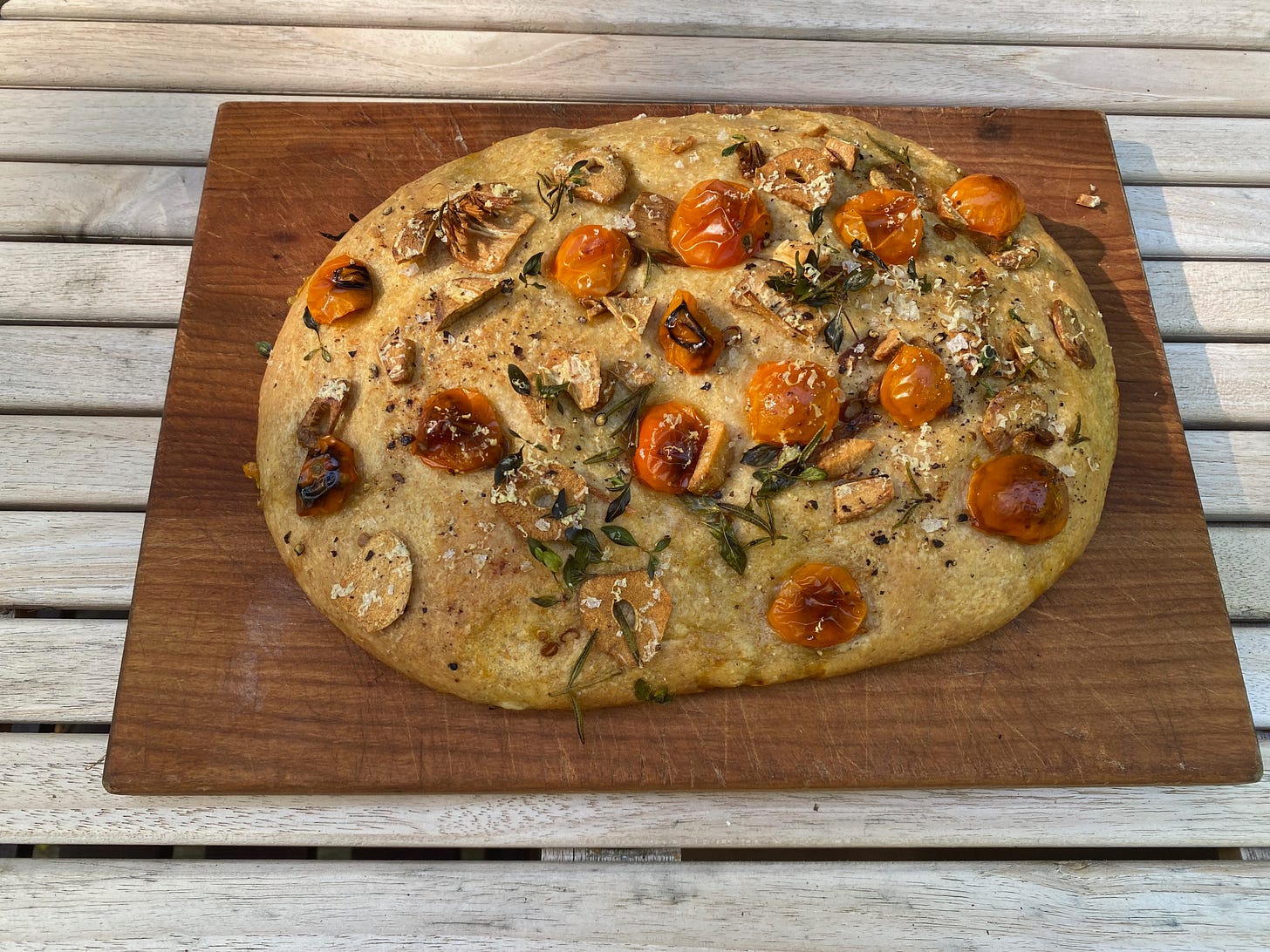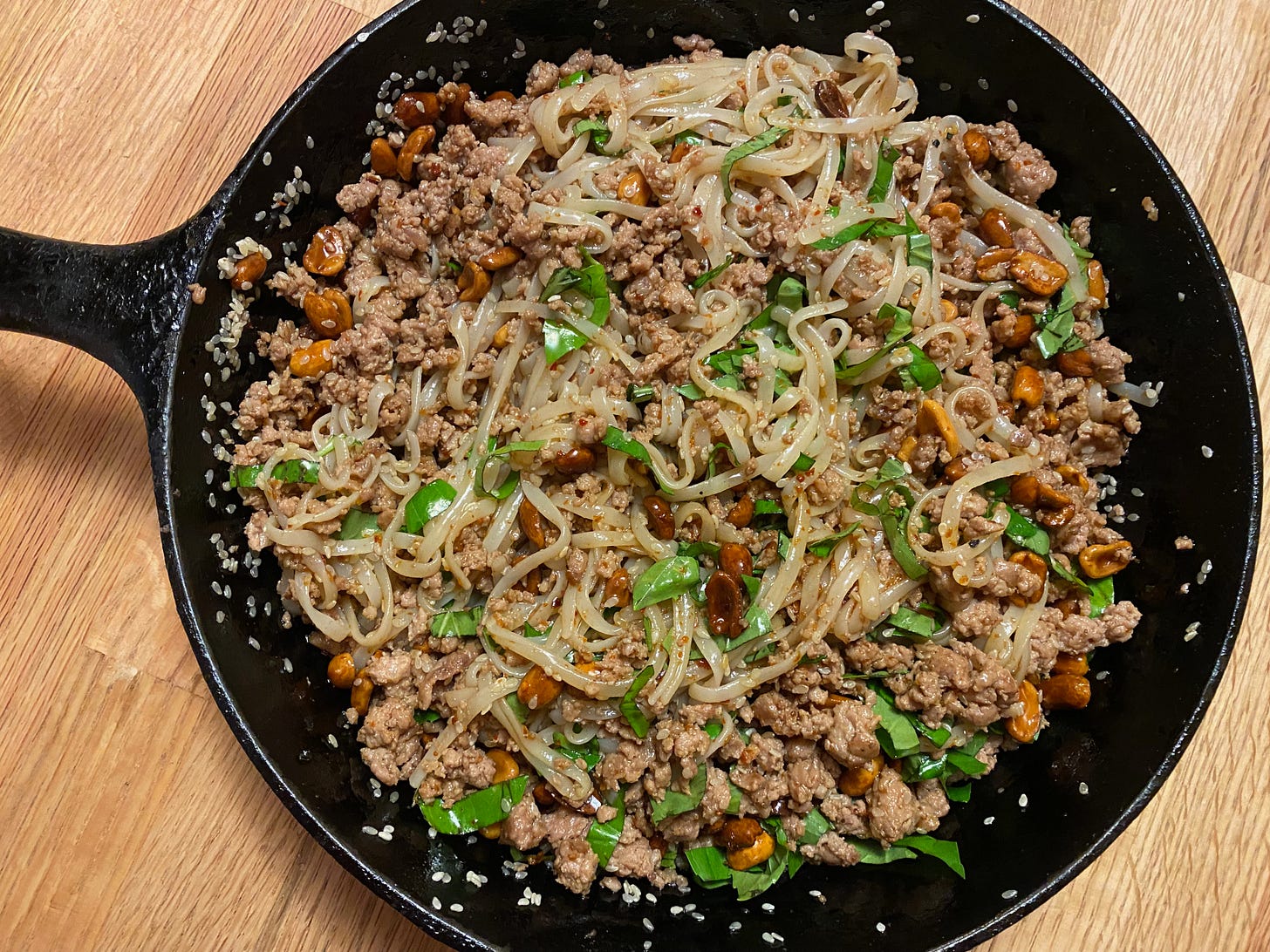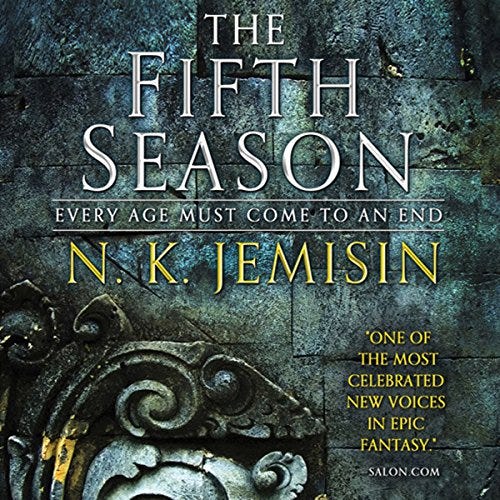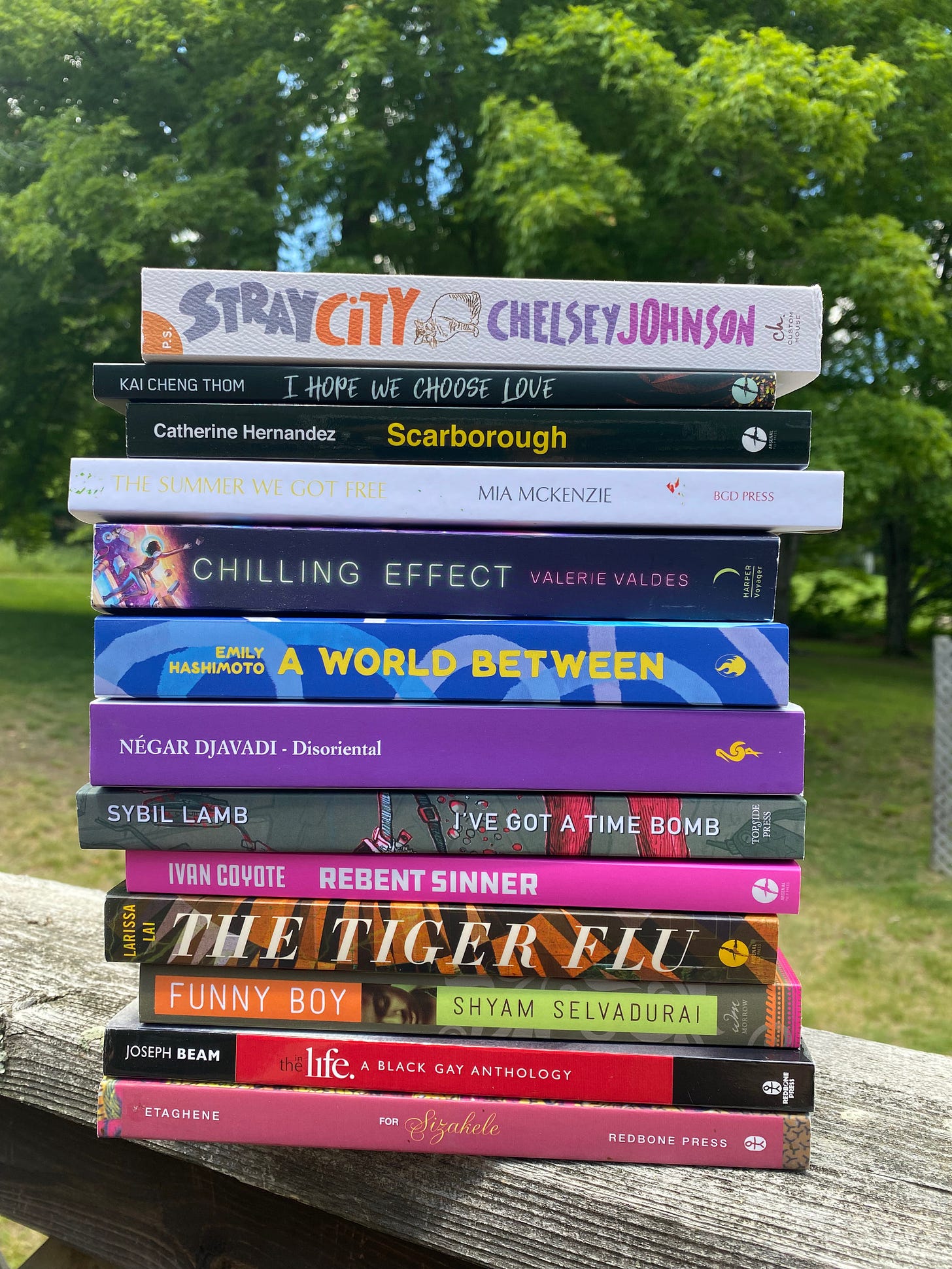Greetings, book and treat people! There was this glorious day over the weekend that was cool and breezy and felt like September and I’m still riding the high. Maybe if I close my eyes and tap my heels three times we can skip straight to fall.
Unlike summer, I’d like to linger in this week’s books forever. They have lush prose that I just want to swim through. They lean hard on the scene, lingering in moments even when they’re uncomfortable. They are books in which characters linger—in places, in relationships, in certain states of mind. The lingering that happens in all of these books is different, but the result, for me, was the same: I devoured them quickly, but I didn’t want them to end.
The Books
Backlist: Rainbow Milk by Paul Mendez (Fiction, 2021)
This is one of those books that feels too big for a review. There is so much going on inside it, so many layers. It opens in 1959, with this gorgeous, heartbreaking soliloquy delivered by a Jamaican immigrant, former boxer, and skilled gardener who is trying to take care of his two young kids amidst illness, poverty, and the endless racism his family faces in the UK.
Then it jumps to the early 2000s to focus on Jesse, a Black gay man who grows up with with his mom and white stepdad in a small town in the Black Country. His parents are Jehovah’s Witnesses, and he suffers through the blatant homophobia and causal and outright racism of the mostly white congregation. At nineteen, after being kicked out of the church, he leaves home for London, where he does sex work to get by as he slowly builds a life for himself. The two stories do eventually come together, and there is so much richness and complexity in the spaces where they intersect.
What’s truly extraordinary about this novel is that while it covers about fifteen years (plus the 1959 section), it’s essentially just a few long scenes. These scenes are pages and pages and pages—some of them go on for more than one chapter. Mendez lingers in scene much longer than most writers dare to.
It’s a master class in scene writing, but it doesn’t read that way. I didn’t even notice what Mendez was doing until I finished the book, because I was so caught up in Jesse’s life. When I say Mendez lingers, I mean he lingers. One of the longest scenes in the book (about 60 pages!) depicts a pivotal moment in Jesse’s relationship with his white housemate, Owen. It’s Christmas and they’re alone in the house. They talk. They make dinner. They talk some more. They move from the kitchen to the dining room to the living room. It goes on and on and on. Every time I thought it would end, it just kept going. I wanted a break, a moment to pause and digest all the emotional intensity. But there are no breaks.
Life doesn’t unfold in scenes. We don’t get breaks from our own lives. We just keep on living. Mendez captures that feeling with these endless scenes. Jesse keeps on living. He has to keep on living through the awkward moments and the painful ones. When the conversation goes to a scary place, there’s no convenient paragraph break to slip away into. The only way out is through. Mendez’s scenes are full of flashback and memory. They meander; they aren’t linear. But this, too, is how life unfolds: memories arise and capture us; something snaps us back into the present. Again and again and again.
There are some quicker, shorter scenes, too. We get a sense of the bleakness of Jesse’s childhood through a few scenes with his family, at the church, and in the home of a couple whose door he knocks on as a missionary. When he first gets to London, we see his first few encounters as a sex worker. Flashback and exposition hold the longer scenes together, but the heart of the book unfolds over five days. Those five days spool out in one long scene each.
This is such an intimate way to come to know a character. We don’t see Jesse in hundreds of different situations over the years. But we see him so closely in the moments Mendez does invite us into. The long scenes build on each other, inform each other. Every one of them is essential, even though they are not all earth-shattering and life changing.
This structure also creates all of this beautiful empty space. A lot happens off the page that is just as important as what happens on the page. Every time we return to Jesse, sometimes after a few weeks, sometimes after years and years, he’s different. It’s another way that this novel feels so close to real life—this is how we interact with so many people. They walk out of our lives and come back different.
There’s so much more in this beautiful novel that I haven’t even touched on. I’ll just add that I love how messy and unfinished Jesse is. A lot of this book is about internalized racism and homophobia, diasporic identity, the marks religious homophobia leaves, sex and power, interracial relationships, class differences, the fetishization of queer men of color, the idealization of white men as the ultimate ideal of masculinity. Jesse works through all of this, and it’s a lot, and he doesn’t get to some enlightened, evolved place. He is not perfect. He lives in the messy middle of the real world and sometimes he makes choices for pleasure or survival or ease or just because he fucking feels like it even when they don’t line up with his ideals, with the best version of who he imagines himself to be. This is the kind of queer representation I crave—not good, not bad, just honest.
Frontlist: We Do What We Do in the Dark by Michelle Hart (Fiction)
This is not a lingering book. It’s short and sparse, actually, written in beautiful, exacting prose that carries a lot of weight despite its directness. It’s the story of a life-defining affair between Mallory, a nineteen-year-old college student, and a much older married woman who is a professor at her college.
There are a few things that make this book so good, but the one that stands out to me the most is the smallness of Mallory’s POV. The book opens with the affair. Mallory is grieving the death of her mother and falls for the woman with passionate intensity. She becomes immediately obsessed; the woman is all she can see. And even though the book extends beyond the affair—the middle section takes place during Mallory’s childhood, and the last section a few years after the affair ends—the POV remains stubbornly fixed. Mallory can only see what she sees and feel what she feels. There’s no distance between her and the events she’s recounting.
I recently read Body Work by Melissa Febos, and one of the things she talks about is the difference between telling the story of something that happened and telling the story of the story you were telling yourself while it was happening. Mallory is telling herself a story about what happened. She tells herself a story about the affair while it’s happening, and, after it ends, about what it meant. Time passes, but she doesn’t stray from the story.
This novel is the story of the story. We’re so close inside Mallory’s head, but we are not Mallory, and so we get to watch her telling herself this story. It’s not that she’s untrustworthy, or even unreliable. It’s that she’s grieving, she’s a mess, her understanding of herself is so narrow and unformed. It’s that she’s so young. Even at the end of the book, she’s still so young. She can only see what’s right in front of her—what she wants to be right in front of her. As witnesses, we get to experience her visceral need to be understood, her longing for approval, her desire to be good enough. But we can also see what she can’t.
Mallory wants to linger forever. She is desperate to linger in the story of her life, the story of the woman, the story of her mother, the story she’s been telling herself for years—because it takes so much work to write a new story, and it hurts. Who wants to do that? It’s painful to watch her linger, but it is such a relatable experience. Who hasn’t lingered in an easy story? Deconstructing it and building a new one means facing all the hurts and scars lurking underneath.
Hart doesn’t make it easy. Mallory doesn’t tear down the story and build a new one. But she does start to fit the pieces together, to recognize the story she’s telling herself. The novel ends at the beginning. It’s truly lovely.
Upcoming: Gods of Want by K-Ming Chang (Fabulist Stories, One World, July 12)
Chang’s debut, Bestiary is beautiful and strange and disorienting. I couldn’t connect with it, despite being dazzled by the prose. A colleague described it as one long prose poem, and I agree. I can’t remember anything about it now, except that I often gasped at the beauty of the sentences.
I picked up Gods of Want hoping for more of that gorgeous prose and delirious strangeness, and it does not disappoint. But because it’s a story collection and not a novel, I didn’t find it disorienting in the same way. I appreciate some short stories for the way they read like small novels. But the stories in Gods of Want are not novel-like at all. They are eerie, beautiful gems; delicious prose poems unconcerned with plot; dazzling strings of words whose innate music is reason enough to read them. I never wanted this book to end. Every story sings. The way Chang uses language is so lush. It’s everything I love about the best poetry: strange conjunctions, metaphors that don’t make logical sense but feel true, verbs doing all the heavy lifting, startling images that send sentences into chaotic disarray.
This book is very queer and full of rage and desire and loss. The characters are all queer Asian American women, mostly Taiwanese immigrants and their children. It’s about the shapes women fold themselves into, are folded into. It’s about hungry ghosts and the power of names, about food and childhood and diaspora and bodies and everything that haunts: memory, war, exes, unborn children, story. But all of that feels secondary to the language itself. Who cares what this book is about. It is music I wanted to bathe myself in forever. Chang’s writing has a specific but mysterious quality that makes it both sacred and playful. At times it seems like she is writing simply to delight in what words can do. It is joyful and prickly. I don’t know how to explain it except to say that these stories feel thick, substantive, like little snacks with claws that bite you when you eat them.
Here’s a passage from one of my favorite stories, “Auntland” which is three pages of stunning descriptions of the narrator’s many aunts:
I had an aunt who never married and told me men are magpies: They want anything that shines. What shines: blood, a bruise like an eye patch, a lake, salt, a window, dew, sweat on a girl’s collarbone, my aunts pledging allegiance to the moon. I had an aunt who massaged my elbows when I cried and said the heart is a hinge, to live it must bend. I had an aunt who said I should carry a rock in my palm until it’s the same temperature as my body, and then I should talk to the rock as if she is inside it. She says we should all learn to listen through other skins.
The magic of this passage, and the whole book, is that it is both whimsical and serious. It flows with so much strangeness. Yet it is also piercingly specific. Why do these aunts pledge allegiance to the moon? Why massage a person’s elbows? The details are precise. There are stories upon stories buried here, and then there is this simple, gutting truth: “we should all learn to listen through other skins.” Sometimes I encounter gorgeous writing that feels empty, like there is no weight behind it. Chang’s prose isn’t like that. It holds itself up. I felt every syllable.
In another favorite story, “Resident Aliens”, a family rents out their basement to a series of widows. Each widow comes with her own messes. Again I was struck by how much humanness Chang writes into every passage:
The fifth widow could brew tea out of anything: leaves from our trees, trash from the gutters, newspaper, pages of the Bible, toenails.
This tea will make you holy, she said, while boiling pages of hymns in hot water, telling me to sip slow, to sing each word before I swallowed.
Later in the same story, after one of the widows writes letters to her husband all over the family’s living room walls, the narrator says: “My aunts said it was unfair for some people to own a language that could not be sold to others, a language as private as the blood inside our bodies.”
First of all, there are a lot of aunts in this book, a lot of mothers and sisters and girlfriends and wives. There are one or two brothers, and then there are men who lurk on the periphery as danger, as monsters, as inconsequential but unavoidable shadows. The sheer sapphic-ness of it is breathtaking. Second—where do I even start with this sentence? I could write a whole paper on many of Chang’s sentences, and this is one. There’s so much it’s saying and not saying about migration and exile, about agency and power, about what and who belongs.
I’d like to share a dozen more passages and tell you about the rest of the stories, because I loved every single one. I’ll refrain. I will say that this is one of the queerest books I’ve read in a while—there’s not a straight POV character that I can recall. All of the women and girls are queer, and there’s something about it that feels revelatory. Certain western ideals and expectations of queerness are distinctly absent. The queerness isn’t subtle, it’s everywhere—there is a lot of wonderfully written queer sex—but it feels…innate. Whole. Undisputed. Sometimes it’s a source of conflict, although more often conflict stems from other things, and sometimes it’s a source of joy. Mostly, it just is.
It’s out July 12th and you can preorder it here.
The Bake
The herbs in my garden are growing, and that combined with the lovely cool weather over the weekend inspired me to make this summery focaccia! It’s an easy, forgiving dough that you can top with basically anything. This combo of cherry tomatoes, fresh herbs, and garlic is divine, but it would be equally good with just olive oil and salt on top. It’s the kind of loaf that invites lingering with friends at the table, everyone tearing off pieces until it’s finally gone.
Tomato Focaccia with Herbs & Fried Garlic
This recipe makes three small focaccias. You could halve it, or you could freeze 2/3 of the dough for later. Just wrap the risen dough balls in plastic and thaw them overnight before shaping. The topping is for three loaves, though, so plan accordingly!
Ingredients
For the dough:
3 3/4 tsp active dry yeast
1 1/2 cups warm water
3/4 cup olive oil
1 Tbs salt
2 tsp sugar
515 grams (4 cups) all-purpose flour
130 grams (1 cup) whole wheat flour
For the topping:
2/3 cup olive oil
6 garlic cloves, peeled and thinly sliced
~20 cherry tomatoes
A handful of fresh herbs (rosemary, thyme, sage, oregano, whatever you want)
3 Tbs grated Parmesan
Flaky salt and pepper
Make the dough: In a large bowl, combine the water and yeast and let sit until the yeast starts to foam, about five minutes. Add the olive oil, salt, sugar, and flours. Mix with a wooden spoon until a rough dough forms. Turn onto a lightly floured surface and knead until smooth and elastic, about 8 minutes.
Scrape the bowl clean and oil it. Plop the dough back in, cover it with a dish towel, and let rise until doubled in size, 1-1 1/2 hours.
Make the topping: Heat the oil in a small skillet over medium heat. Add the thinly sliced garlic and cook, shaking the pan every now and then, until the garlic has just started to turn golden, 2-3 minutes. Halve the cherry tomatoes. De-stem the herbs but don’t chop them.
Assemble the bread: Divide the risen dough into three equal balls. If you’re not going to use them all right away, wrap two in plastic wrap and freeze.
Oil two baking sheets. Preheat the oven to 400. Gently stretch and pat each dough ball into a rough oblong—two on one baking sheet and one on another. Gently press dimples into the dough’s surface with your fingers. Spoon or brush the garlic oil evenly over the loaves, then scatter the semi-fried garlic pieces, cherry tomatoes, and herbs on top. If you have extra oil, pour it onto the baking sheets around the loaves. It makes the top and bottom crusts extra crispy and delicious. Scatter a tablespoon of Parmesan over each loaf, and top with flaky salt and pepper. Let rise, uncovered, for 30 minutes.
Bake for about 25 minutes, until the focaccias are lightly golden and spring back a bit when you press on them. Let cool before serving.
The Bowl and The Beat
The Bowl: Spicy Pork & Sesame Noodles
I made this the other day in the midst of a hangry meltdown. It saved the day! It’s similar to many other quick rice noodle dishes I’ve made, but it’s extra delicious and feels fancy because of the chili oil and roasted peanuts—a flavoring that is actually very easy to make.
In a small heatproof bowl, combine 1-2 tablespoons red pepper flakes or other chili flakes, a tablespoon of sesame seeds, 1-2 tablespoons soy sauce, and a glug of toasted sesame oil. In a small skillet, heat 1/2 cup neutral oil (sunflower, vegetable, grapeseed) and add a big handful of peanuts (6 tablespoons or so). Cook over medium heat, shaking the pan every now and then, until the peanuts are a lovely golden brown and the oil is bubbling. Pour the oil and the peanuts into the chili mixture and set aside.
In a large skillet, sauté a pound of ground pork until cooked through. Add a few tablespoons of the chili oil and mix well. Stir in a package (8 ounces) of cooked rice noodles, and more chili oil. Keep stirring and adding chili oil until everything is well mixed and evenly coated. I topped it with chopped basil because that’s what I had. Cilantro, scallions, and/or chives would be great.
I did not have any vegetables around, but broccoli, bok choy, green beans, snow peas, or some other quick-cooking green would make this even better.
The Beat: The Fifth Season by N.K. Jemisin, read by Robin Miles
I’ve read this twice, once in print and once on audio. I usually save my rereading for December, but when I was struck with the sudden urge to reread this series, I decided to give myself permission. It’s one of my favorite books of all time. It’s also one of the most structurally brilliant books I’ve ever read. I knew what I was getting into, and even so, I wasn’t prepared for the experience. There is simply nothing like it: so emotionally devastating and so deeply human and so technically breathtaking, all at the same time.
I’m listening to the second one now, and it’s making me rethink my whole “can’t do fantasy right now” thing. Yes, this world is familiar. And Jemisin’s world-building is also outrageous; it’s so good you basically don’t notice it. These things make it easier for my brain to connect. But if you stripped away all the magic in this series, the fantasy setting, the mysteries, the action, 90% of the plot—what makes it so incredible would remain. It’s about characters and their relationships. I’m not expecting to come across the next Jemisin anytime soon, but it’s a nice reminder that what I’m currently craving—emotional, character-driven queer stories—does exist in fantasy, too.
The Bookshelf
A Picture
Almost exactly a year ago, I posted this picture of queer books I own that I wanted to read soon. Let’s do a check-in! A year later, how many of these have I read? 5/13! Honestly, I think that’s pretty good. They include: I Hope We Choose Love, Scarborough, The Summer We Got Free, A World Between, and Rebent Sinner. Maybe I’ll have read the rest by next June!
Around the Internet
On Book Riot, I took a deep dive into ARCs and why reviewers include disclaimers about them. I also made a little list of bookish ways to celebrate Pride.
More Books I Wanted to Linger In Forever
The Goldfinch is a little too obvious, but in all honesty, I would happily listen to 30 more hours of the 30ish hour audiobook. I’ve listened to it twice and I’ll listen to it again. It’s a masterpiece. Fight me. Maria Dahvana Headley’s new translation of Beowulf is another one: I could have read that book forever. The audio, narrated by JD Jackson, is perfection. Thick by Tressie McMillan Cottom also merits lingering—her essays are so densely packed with so much brilliance that the only way to read them well is to read them slowly.
The Boost
I try to keep this section mostly focused on ways to help and/or orgs and people to support. But I don’t always have time to vet and collect links with as much care and thoughtfulness as I’d like. So, this week, an old favorite: the most useful baking resource on the internet.
As always, a little bit of beauty to send you on your way: It’s all flowers all the time for me. This rose was here when I moved in. It’s still a little scraggily, but it started blooming, and I love it.
Catch you next week, book people!










I’m fascinated by your description of the structure in Rainbow Milk. I want to read it to see how those scenes work.